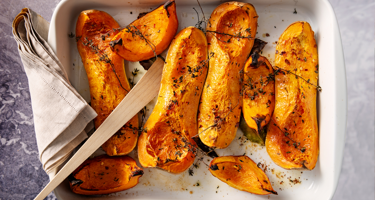
Butternut squash is more than just an autumn staple; it is a kitchen all-rounder with sweet, nutty flesh that works for all sorts of dishes. From creamy soups and roasted sides to hearty stews and sweet bakes, this winter squash fits effortlessly into both weekday meals and special dishes.
In this guide, you will learn when it is in season, how to prep and store it, and what to do with the skin, seeds, and flesh. Whether you are dicing it for a traybake or blending it into a creamy purée, you will find plenty of tips to help you along the way.
What is butternut squash?
Butternut squash (Cucurbita moschata) is a medium-to-large winter squash with a bell or pear shape, smooth tan skin, and a bright orange flesh. It has a sweet, nutty flavour similar to pumpkin but slightly richer and creamier, making it especially popular for both savoury and sweet recipes.
The squash belongs to the gourd family (Cucurbitaceae), alongside pumpkins and zucchinis and has a firm texture that becomes soft and creamy when cooked.
When is butternut squash in season?
Butternut squash is in season in late summer through early autumn and typically planted back in late spring or early summer. Its peak season is from September to March, though its long storage life means you can find it year-round in most markets. If you are in the Northern Hemisphere, autumn and early winter are the best times to enjoy it at its freshest.

What is the origin of butternut squash?
The origin of butternut squash goes back to the 1940s in Massachusetts, when a man named Charles Leggett decided to cross a few different squashes to make one that was sweeter, smaller, and easier to ship. He succeeded, and when he described its texture as “smooth as butter,” the name practically picked itself.
Although its parent species, Cucurbita moschata, has been grown in the Americas for thousands of years by Indigenous peoples, this exact variety is a more modern creation. Since then, butternut squash has spread far and wide, becoming one of the most popular winter squashes around. In Australia and New Zealand, you might even hear it called “butternut pumpkin.”
How to cook butternut squash
Butternut squash is one of those vegetables that is hard to get wrong, and there are so many ways to cook it. You can roast it, steam it, or toss it in a stew, depending on your preferences. Here are some of the most popular ways to prepare it, with tips for getting the best results every time.
How to roast butternut squash
Roasting butternut squash is the most popular method because it brings out its natural sweetness and gives it a fantastic, caramelised finish.
Step-by-step for roasting:
Preheat the oven to 190–220 °C.
Peel and cut the squash into cubes or halves (see cutting guide below).
Toss the pieces with olive oil, salt, and pepper. Add spices like paprika, cinnamon, or cumin for extra flavour.
Spread the cubes on a baking sheet in a single layer.
Roast for 30–45 minutes, turning halfway through.
If you want to roast a whole butternut squash, cut it in half lengthwise, scoop out the seeds, season lightly, and roast cut-side down for about 45–60 minutes until fork-tender.
Try it for soups and purées
If you want to use butternut squash for soups or purées, start by peeling and cubing it, then simmer it in vegetable or chicken stock until fork-tender. It is a natural fit for smooth soups and puréed dishes. Its flesh becomes rich and velvety when cooked, with a mild sweetness that pairs well with warm spices like cinnamon, nutmeg, or smoked paprika. You can try this method in our butternut squash soup recipe, or for a more filling option, try the butternut squash and potato soup, which combines it with root vegetables.
How to steam butternut squash
Cut the butternut squash into evenly sized chunks, then place them in a steamer basket over simmering water for about 10–15 minutes, until they are soft. It is a quick preparation method and helps the squash keep more of its flavour compared to boiling. Once it is soft, you can mash it, blend it into soups, or mix it into muffins and savoury bakes.
Air-frying butternut squash
If you are short on time, the air fryer is a fantastic option. Simply peel and cube the squash, toss it with a little olive oil and your favourite seasoning, for instance, garlic powder, paprika, or rosemary. Then cook at 190 °C for 15–20 minutes, giving the basket a shake halfway through. You will get golden, caramelised edges and a soft, creamy middle, all with barely any oil. Crispy on the outside, tender on the inside, and perfect for throwing into bowls, wraps, or just snacking straight from the basket. You can try using the seasoning blend from
Baking with butternut squash
To prepare butternut squash for baking, roast or steam the flesh, then mash or blend until smooth. Thanks to its natural sweetness and creamy texture, it really shines in baked goods. When puréed, it adds moisture and a subtle flavour that complements spices like cinnamon, clove, and ginger. Use it in place of pumpkin in recipes like our pumpkin pie or grate it directly into the batter of
How to cut and peel butternut squash
Cutting a butternut squash can feel like a bit of a workout, but it is easy once you know the steps.
Here is how to do it safely:
Slice off both ends so it sits flat.
Peel the skin with a sharp vegetable peeler.
Cut it in half lengthwise and scoop out the seeds.
Cut into slices or cubes depending on your recipe.
Can you eat the skin of butternut squash?
Yes, you can eat the skin of butternut squash once cooked. That said, whether you should eat it depends on the texture you prefer. Butternut squash skin tends to remain relatively tough and leathery, even after roasting, which is why many prefer to peel it, especially when using the squash in soups, purées, or bakes. However, if you do plan to eat the skin, choose organic squash where possible and scrub it well before cooking to remove any dirt or residue.
How to prepare butternut squash seeds
Butternut squash seeds make for an amazing snack, so do not throw those seeds away when you scrape out your squash. Like pumpkin seeds, butternut squash seeds are edible and very easy to roast, perfect for snacking or sprinkling over soups, salads, and grain bowls.
How to roast the seeds:
Rinse the seeds well to remove any pulp.
Pat dry, then toss them with oil and your favourite seasonings.
Spread on a baking sheet and roast in the oven at 165–200 °C for 10–20 minutes, stirring halfway.
Let them cool, then store them in an airtight container.
How to store butternut squash
To keep your butternut squash fresh and flavourful, the way you store it makes all the difference. Whether it is whole, cut, or cooked, here is how to maximise its shelf life.
Whole: Store in a cool, dry place (around 10–13 °C) with good airflow. Do not refrigerate whole squash, as the cold can shorten its life. Properly stored, it can last 2–3 months, sometimes longer.
Cut: Once peeled and cubed, store in an airtight container in the fridge and use within 3–5 days. Cooked squash will keep in the fridge for up to a week.
Frozen: Peel and cube raw squash, spread on a tray, freeze, then transfer to a bag or container. Frozen butternut squash lasts 3–6 months.
Learn more about different pumpkin types
If you have enjoyed learning about butternut squash, there is plenty more to explore in the world of pumpkins and squash. For a full overview, check out our guide on
and dive into the distinct qualities of favourites like red kuri squash, spaghetti squash, and the classic Halloween pumpkin.
When you are ready to cook, our recipe collections are the perfect place to start. We have pumpkin recipes that cover sweet and savoury ideas, to the smooth and all-round butternut squash recipes, and the sweet, nutty red kuri squash recipes. Whatever you choose, you will find plenty of seasonal flavour to enjoy.



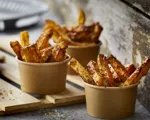



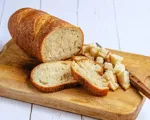







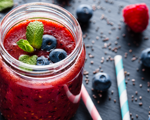

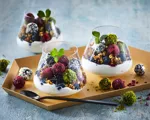
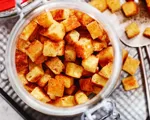
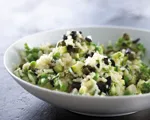
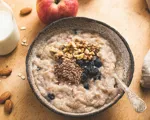
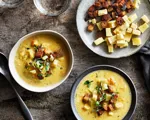
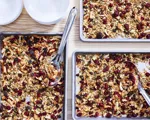
&format=webp)
&format=webp)

















